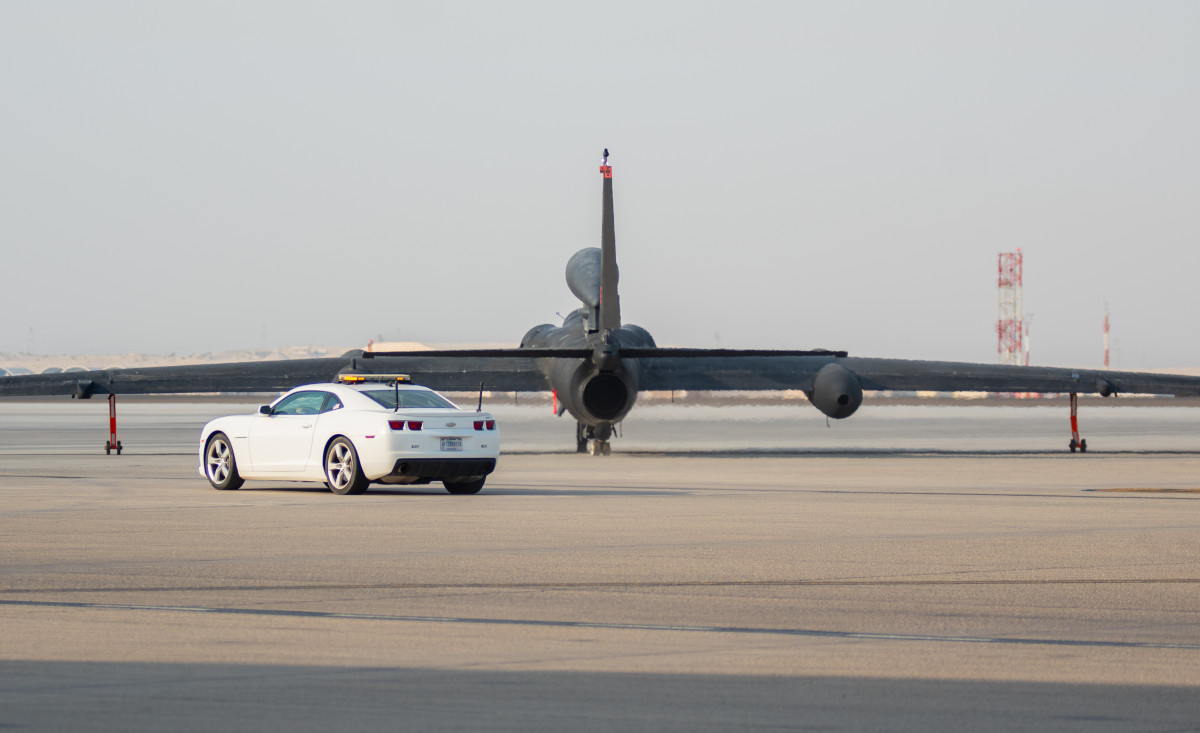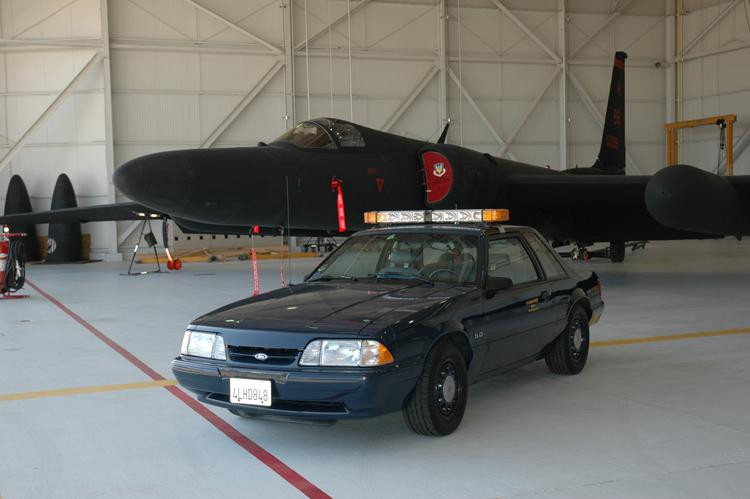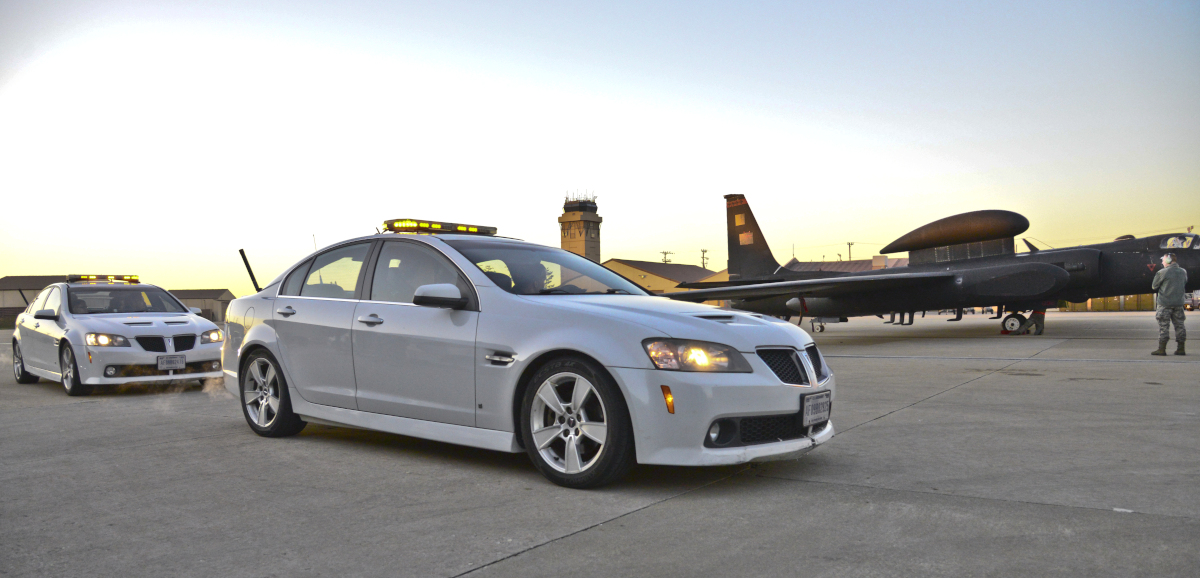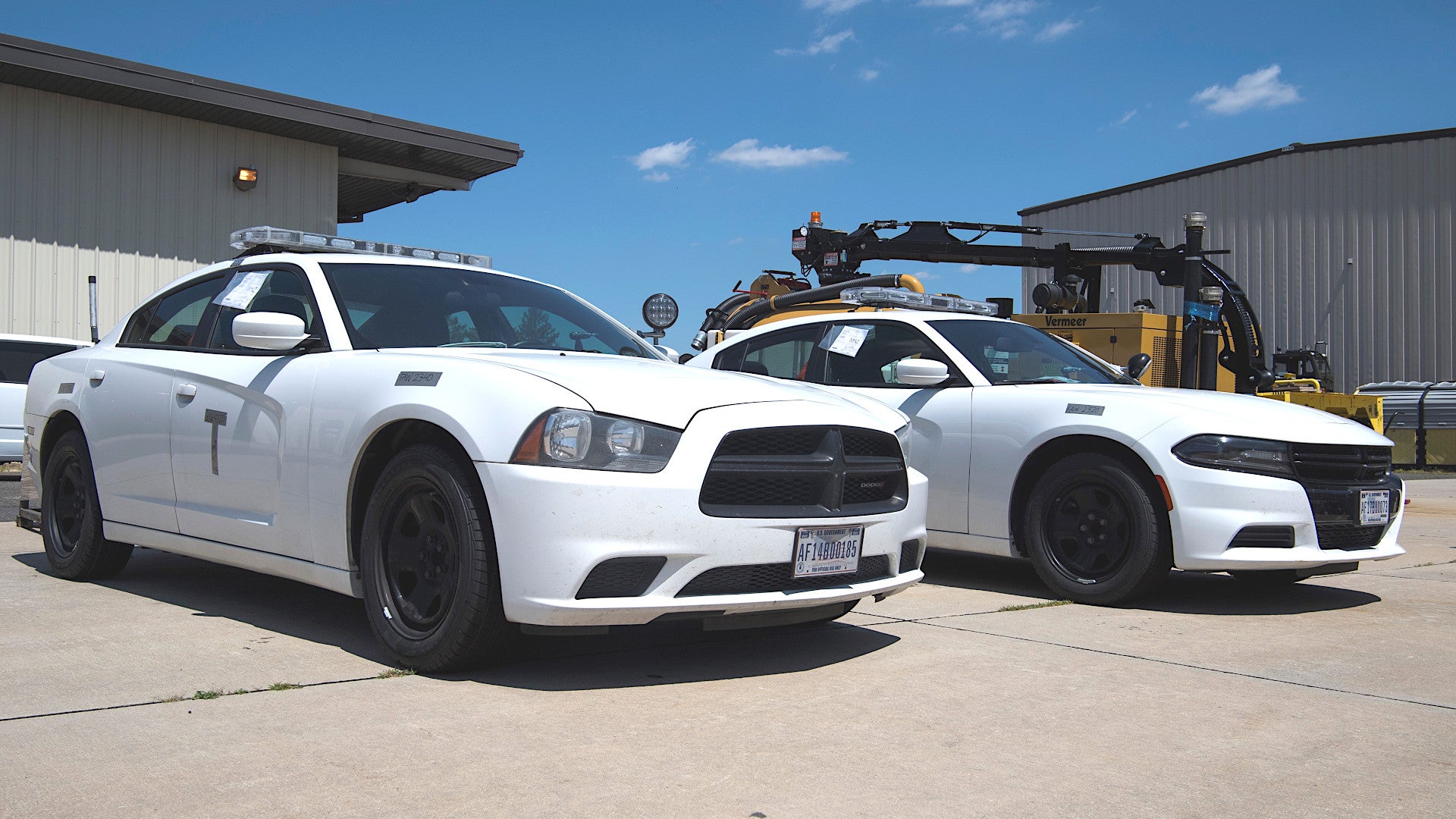Two Dodge Charger chase cars the Air Force uses to help U-2 Dragon Lady spy planes land are hung up in red tape at Joint Base McGuire-Dix-Lakehurst in New Jersey as the service works to clear them to fly aboard one its transport aircraft to RAF Mildenhall in the United Kingdom. It’s not entirely clear how this has happened or why the Air Force has chosen what will invariably be the very costly option of shipping these cars via airlifter across the pond, to begin with.
The Air Force first revealed the cars’ predicament in a news story on Aug. 21, 2019. It’s not clear when the cars first arrived at Joint Base McGuire-Dix-Lakehurst (JBMDL), but they were there at least as of Aug. 12. Four days later, the 305th Aerial Port Squadron received orders to get them ready to go to RAF Mildenhall. An unspecified support truck is also part of the prospective shipment.
The Air Force utilizes chase cars to help U-2s land, as well as take off, at bases in the United States and abroad. The Dragon Lady is notoriously challenging to land given that it only has a pair of fixed landing gear in the center fuselage, offers limited overall visibility to the pilot, and a glider-like design that can stay aloft even at relatively low speeds. The plane’s long slender wings are so efficient that the design’s very first flight occurred accidentally during a ground test.
While on the ground, the U-2 utilizes a “pogo” gear under each wing, which both fall away after takeoff, to keep stable. When landing, the pilot has to keep the aircraft relatively stable and centered until they’re just a few feet off the ground, before effectively stalling the aircraft and falling the rest of the way.

Initially, the Air Force used T-33 jet trainers to help act as spotters to talk pilots in. The service quickly shifted to chase cars that would speed down the runway right behind the Dragon Ladies and assist with the landing process. The drivers are all U-2 pilots themselves, so they know exactly what factors are at play.
The video below offers a look into how U-2 chase car drivers help the Dragon Ladies get back down on the ground.

Various makes and models of cars, sometimes derived from police car configurations, have performed this role over the years, including various models of Chargers, which have been in service for years now. Pontiac GTOs, Chevy Camaros, and even a Tesla S, have performed these duties, as well. NASA has also employed at least one Charger to support its ER-2s, which are variants of the spy plane converted to perform scientific and other research tasks.

“The chase vehicles we received have no Air Transportability Test Loading Agency certification,” U.S. Air Force Staff Sergeant Ryan Murray, the 305th’s load planning supervisor, said. “They have no fixed area to be restrained or tied down in the aircraft, so there’s no black and white way on how to transport them. When they arrive to our area like that, they are deemed non-airworthy and that’s when we have to figure out how we can load them safely or we may have to make the call that we can’t load it.”
The Air Force’s official news story did not say what aircraft the service intended to ship the chase cars on. There are C-17 Globemaster III airlifters and KC-10 Extender tankers, the latter of which have an important secondary transport capability that you can read about more here, based at JBMDL that could handle the mission.

As of Aug. 21, the 305th was coordinating with Air Transportability Test Loading Agency (ATTLA), which is based at Wright Patterson Air Force Base in Ohio, to get the two cars certified. This has included taking measurements and weights of the vehicles in order to develop a load plan for the vehicles.
“We have to do a full inspection of the vehicle to see how much weight is on each individual tire, both axles weighed together, the total weight of the vehicle, ground clearance and check the overhang on the front and rear of the vehicle to see if it can go up an aircraft ramp or not,” Staff Sergeant Murray explained. “Once we have those measurements, an ATTLA engineer takes the info to create a certification on how to move that cargo.”
It’s true that airlifting the cars by aircraft, just like airlifting any cargo, is more complicated than just loading them on and tying them down. Loadmasters must ensure the exact distribution of the weight doesn’t dangerously impact the aircraft’s handling and that the vehicles remain firmly in place during flight. A sudden shift in weight could have deadly consequences.
That said, it’s not clear why the Air Force doesn’t have standardized loading plans for the Dodges or certifications for these particular cars, or other chase cars, in order to send them overseas. The U-2s generally use a number of well-established operating locations, which would all have equally known demands for chase cars.
As noted, the service has been using chase cars to help U-2s land for decades and has been using various Charger models, specifically, for years now. The aforementioned Tesla S supported Dragon Lady operations at RAF Fairford in the United Kingdom in 2017, though we could not quickly determine its current location and status.

“If ATTLA is unable to certify the vehicles for flight, the vehicles may potentially be shipped by boat or sourced at the end destination,” the Air Force said in its story. This raises additional questions about why the service is even shipping these cars to RAF Mildenhall, at all.
We don’t know how much it might cost in the end to put the Chargers through the certification process and the total expense the Air Force will incur to fly them to RAF Mildenhall, but we can estimate the basic cost of the flight from New Jersey to the United Kingdom, which would be around eight hours long. The cost per flight hour to operate various Air Force aircraft fluctuates due to a number of factors, but, as of 2013, it was $23,811 for the C-17 and the $21,10 for the KC-10. Use the larger C-5 Galaxy at that time ran $78,817 per hour.
This means the flight alone would cost about $190,000 at least just to get the cars to RAF Mildenhall, plus nearly an equal amount for the airlifter to return to the United States afterward. This could be offset to some degree if there is cargo that could be flown on the return leg, though.
There’s no requirement for the Chargers specifically to perform this function. As noted, various other vehicles have met the performance requirements necessary to act as chase cars and could accept the other requisite modifications, including installation of various radios, necessary for this mission. The Air Force has said itself that it could source vehicles in the United Kingdom if it comes to that.

It is possible that RAF Mildenhall, specifically, doesn’t have chase cars in place, but U-2s do regularly visit RAF Fairford. This brings up the question of why there isn’t a permanent fleet of chase cars available in the country already, part of which could be temporarily redeployed to RAF Mildenhall, or why the Air Force doesn’t just send them to Fairford as usual. It seems difficult to believe that these bases, which have motor pools, would find it difficult to maintain a small fleet of appropriate cars to support Dragon Lady operations, as necessary.
Having fleets of chase cars in place at any established base that is at all a regular U-2 deployment location would certainly seem more cost-effective than having to fly in chase cars to these locales constantly or even sporadically. This could also be particularly important in the future if there is a need to rapidly deploy or reposition U-2s to meet operational demands, but airlift assets are strained or otherwise prevented from reaching forward-deployed sites.
We will have to wait and see when and if the Air Force does get the two Chargers certified to fly to the United Kingdom. Depending on how long it takes, especially if they can’t get approval, it will only underscore the question of whether it would have made more sense just to buy suitable vehicles there in the first place. A Charger Police Interceptor sells for roughly $33,000 to $40,000 in the United States. With chase car modifications, let’s say the cost is $45,000 per vehicle. That means that a fleet of four vehicles could be bought and stationed in the UK for the estimated price of just the inbound leg of the proposed mission, based on generalized figures. Certainly, there are similar off-the-shelf vehicle options available in the United Kingdom, too.
It sounds so grossly illogical and wasteful that only the Department of Defense could come up with such a rationale to support it. At the very least, it seems like a case of remarkably poor planning. Then again, maybe there is something we are missing.
Contact the author: joe@thedrive.com
